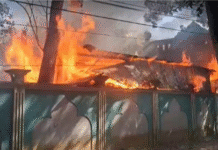
They noted that a single building collapse (Rana Plaza in Savar) killed nearly 300 people while the government is struggling to carry out search and rescue operation. But if a moderate tremor hits the country, thousands of buildings will collapse and it will be quite impossible for the government to face the situation for lack of equipments in conducting rescue operation.
“Bangladesh is urbanising rapidly (around 35,000 people move to urban areas every week) and almost no buildings conform to building codes, which are anyway weak. Dhaka is also sited on two fault-lines and is vulnerable to earthquakes – several small quakes occurred over the last three years,” said Gareth Price-Jones, Oxfam country director in Bangladesh.
He said despite recent efforts, Bangladesh still has a huge amount of work to do in preparing for an earthquake, particularly in the major cities like Dhaka and Chittagong.
“Both at the government-led policy level, where building codes need to be strengthened and enforced, and at local community and family level, there are a range of key activities and decisions to be undertaken that will help save lives if a major tremor occurs.”
Gareth Price said everyone has a role to play, whether an architect designing buildings, managers agreeing on how to evacuate their factories, or families agreeing in advance where to meet their loved ones after an earthquake when phones aren’t working and homes may be unsafe.
“Bangladesh is one of the top risk countries to earthquake. Many risk factors like unplanned urbanisation remain. People have no proper knowledge about tremor and citizens have no idea what they have to do during earthquake. But, the government’s preparedness is too inadequate to face any earthquake,” seismic expert Prof Dr Syed Humayun Akther told UNB.
He said the government in financial support from the European Union had taken the Comprehensive Disaster Management Programme (CDMP) to strengthen capacity to face disasters.
“Under the CDMP, the government decided to build 62,000 community volunteers to carry out rescue operation immediately after disasters, including earthquake. But, it built only 8,000-9,000 volunteers in last four years.”
He wondered how much more time will be needed to build 62,000 community volunteers and if the volunteers could not be trained properly, the training programme will be ineffective.
Dr Humayun Akther, a teacher of Geology Department at Dhaka University, mentioned the government’s inefficiency and lack of coordination among the government bodies in carrying out rescue operation after earthquake.
He said the government has already procured some equipment to conduct search and rescue operation after disasters, which is inadequate to address any earthquake aftermath.
According to official sources, the Ministry of Disaster Management and Relief has already procured equipments worth Tk 60 crore and handed those to the concerned agencies.
About preparedness to face earthquake aftermath, Dr Humayun said mass awareness should be created among the city dwellers about earthquake so that they can stay in their present built environment during earthquake.
He said the government can make people aware about earthquake through educational television programmes. “Such programmes may include animation pictures on tactics how to take shelter during earthquake.”
Dr Humayun also suggested arranging earthquake demonstration so that people can learn how to escape from a devastating earthquake.
Earthquake expert Prof Jamilur Reza Chowdhury suggested enforcing the building code during the construction of new structures to minimise loss of life and property from earthquake.
“All our preparedness will fall flat if we can not enforce the building code in constructing new structures and in removing vulnerable buildings,” he said.
According to a CDMP study, some 78,323 buildings will be destroyed completely if a 6-magnitude earthquake shakes Dhaka originating from Madhupur Fault, causing havoc in the densely populated capital city.
In case of a 7.5-magnitude earthquake originating from Madhupur Fault (near Dhaka city), some 72,316 buildings in the capital will be damaged totally and 53,166 others partially. If an 8.5-magnitude tremor from the plate boundary of Fault-2 hits the region, some 238,164 buildings will be destroyed completely across the country.









